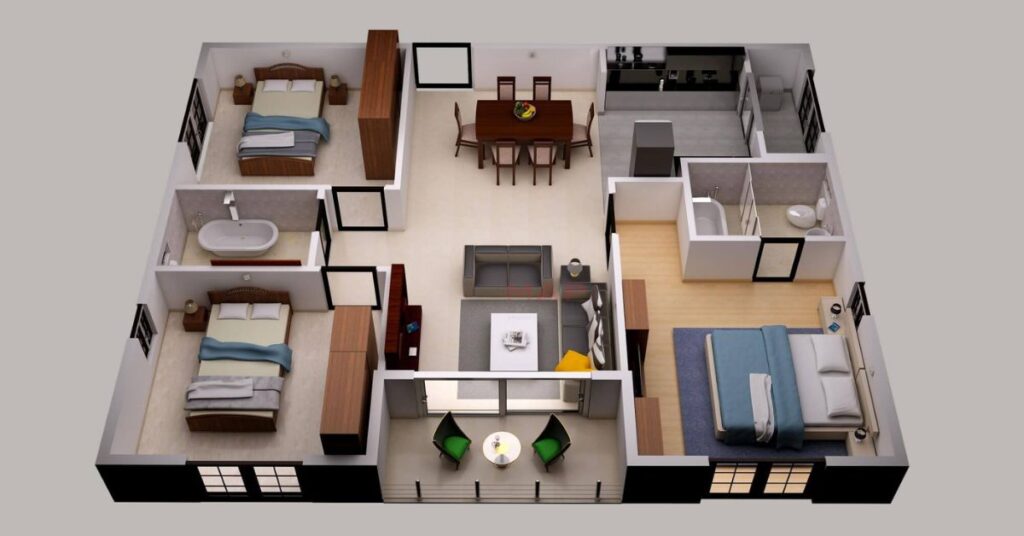A well-thought-out floor plan is the foundation of a comfortable, functional, and aesthetically pleasing home. Whether you are building a new residence or renovating an existing one, the right floor plan ensures efficient space utilization and enhances the overall living experience. With the help of experienced architects in Chennai, you can create a floor plan tailored to your lifestyle, preferences, and future needs.
Understanding the Importance of a Floor Plan
A floor plan is more than just a blueprint; it is a guide that dictates how spaces connect and function. A well-designed layout offers:
- Efficient Space Utilization – Maximizing available space to suit your daily activities.
- Smooth Flow and Accessibility – Ensuring easy movement between rooms.
- Aesthetic Appeal – Creating a visually balanced and appealing home.
- Future Flexibility – Allowing for potential modifications as your needs evolve.
- Energy Efficiency – Optimizing natural light and ventilation to reduce energy consumption.
Key Considerations in Designing a Floor Plan
1. Identify Your Lifestyle Needs
The first step in designing the perfect floor plan is to assess your lifestyle. Do you need a large open-concept living area for family gatherings? Are you looking for a dedicated home office space? Identifying your priorities will help you determine the ideal layout.
2. Consult an Architect
An architect plays a crucial role in transforming your vision into a practical and well-structured floor plan. They analyze your requirements, site conditions, and budget to create a design that balances functionality and aesthetics. An experienced architect ensures your home meets structural and safety regulations while incorporating innovative design elements.
3. Optimize Room Placement
Strategic room placement improves comfort and convenience. Consider the following:
- Bedrooms: Should be positioned in quieter areas away from noisy spaces like the kitchen and living room.
- Kitchen: Ideally located near the dining and living areas for easy accessibility.
- Bathrooms: Should be distributed efficiently, preferably near bedrooms and common areas.
- Storage Spaces: Must be included to keep the home organized and clutter-free.
4. Prioritize Natural Light and Ventilation
A well-lit and airy home enhances comfort and reduces energy consumption. Large windows, skylights, and proper room orientation help in maximizing natural light and ventilation. An architect can guide you on the best ways to position windows and openings for optimal airflow.
5. Consider Future Expansion
A home is a long-term investment, and your needs may change over time. If you plan to expand in the future, ensure your floor plan allows for extensions or modifications. Discuss potential growth options with your architect during the planning phase.
6. Maintain a Balanced Layout
A well-balanced layout ensures that no space is wasted while maintaining symmetry and flow. Avoid unnecessary hallways, ensure rooms are proportionate, and create a seamless connection between indoor and outdoor areas.
7. Incorporate Smart Home Features
Modern homes integrate smart technology for convenience and efficiency. Consider including:
- Automated lighting and climate control systems
- Smart security features
- Energy-efficient appliances and fixtures
- Home automation for enhanced control
8. Stay Within Budget
While it’s tempting to include luxurious features, staying within budget is essential. Work closely with your architect to prioritize essential elements while keeping costs in check. A well-planned floor layout prevents costly changes during construction.
Different Types of Floor Plans
Open Floor Plan
An open layout combines the kitchen, dining, and living areas into a single expansive space. It fosters social interaction, improves natural light flow, and makes a home feel more spacious.
Traditional Floor Plan
A traditional floor plan separates different rooms with walls, providing more privacy and defined spaces. This layout suits homeowners who prefer distinct areas for various functions.
Multi-Level Floor Plan
Multi-story homes have distinct zones for different activities. Bedrooms are usually on the upper floors, while common areas like the kitchen and living room are on the ground floor.
Custom Floor Plan
A custom-designed floor plan is tailored to your specific preferences, lifestyle, and site conditions. Working with an architect ensures a unique and optimized design that meets your exact requirements.
Conclusion
Designing the perfect floor plan for your home requires careful planning, creativity, and professional expertise. By working with a skilled architecture firms in Chennai, you can create a layout that enhances functionality, comfort, and aesthetic appeal. Whether you prefer an open-concept space, a traditional layout, or a custom design, a well-planned floor plan will transform your house into a dream home. Take the time to evaluate your needs, optimize space utilization, and plan for the future to build a home that is both practical and visually stunning.



